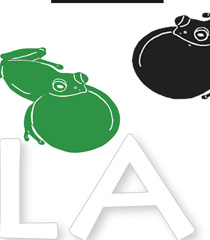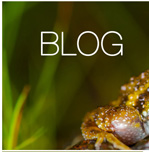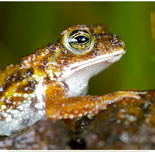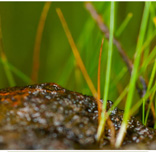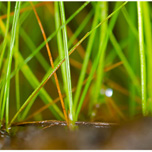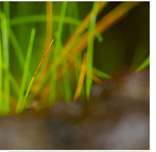 |
 |

Welcome to LOST AMPHIBIABS of INDIA Blog
Lost amphibians of India offers the latest news and developments.
In search of the Manipur frog |
| Posted by Rachunliu G Kamei Delhi University | 10. 01. 2011 | COMMENTS(5856) | | | | |
 | | Search for lost amphibians of India - Biju in 'once upon a time' forest in Kangpat Large tract of land razed for slash and burn cultivation. Photo: Chun G Kamei |
The steamy jungles of the northeast India with its huge potential of amphibian diversity beckoned me to embark on a doctoral research. At the time of joining the Systematics Lab in 2007 I had a plan of doing lost amphibians of India for my PhD. That time Biju also just joined the University of Delhi. There was absolutely no fund for fieldwork and many of my field trips were funded out of his personal money. In 2008 Dr Biju submitted a project to the ASG/IUCN/SSC entitled Amphibians of India: In search of the 'lost species'. We received about 4,000 USD which we used partially for field work. Thanks to Drs Claude Gascon and Robin Moore!
Euphlyctis ghoshi -is one of the 'lost' species from northeast India. The species was described by Chanda in 1991 from "Khugairk Reserve Forest", Manipur. I asked for precise information to several local people belonging to various districts of Manipur about the locality 'Khugairk Reserve Forest' but failed to get any definite answer. Every time I caught a Euphlyctis I always wondered if it could be the lost species. I remember my first frog trip with Dr Biju to a remote village in Tamenglong district of Manipur. At late evening when the gentle monsoon breeze brought light showers of rain frogs started croaking from behind the hut. We grabbed our head torches and followed the croak. We were led to a muddy pond where buffaloes had retired for the day and around them were some Euphlyctis madly calling. We caught hold of one and curiously flashed light on the belly and digit tips but sadly it turned out to be the common Euphlyctis 'cyanophlyctis'!
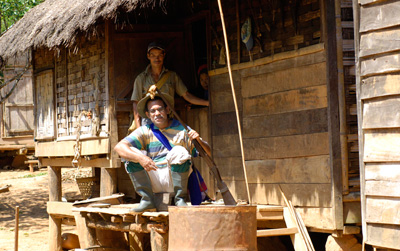 | | Search for lost amphibians of India - Our local guide's home adorned with wild animal skulls, at the gun's tip is probably skull of endangered primate Hoolock Gibbon. Photo: Chun G Kamei |
Biju discussed about Euphlyctis ghoshi and possibility of making a trip. The odds of tracking down this lost frog was high. Logistics in northeast India is extremely expensive, if one is lucky to get. Many of the areas in Manipur state are made inaccessible due to volatile political situation. The last insane thing the local people want to do is hunt for frogs in the forest using flashlights because at turbulent times people shoot first rather than talk!!
After a long debate we decided to go to Ukhrul district of Manipur. Our decision was based on a combination of factors - this district has some good forests and unpredictable high rainfall. Another added 'advantage' was that frogs are a culinary delicacy among the locals and they generally have a good knowledge of at least about the edible frogs! We were keen to explore some far-flung areas in Ukhrul. We decided on a place called Kangpat in Kamjong subdivision - a place notorious for hideouts of armed political outfits, though.
We arrived at Imphal airport at 8.00 am on 27 December 2010. There is only one bus to Kamjong and the bus had left at 6 am. We had two options, either waste one full day and night or hire a cab at an astronomical rate. We wanted to save the scarce resource for the inevitable circumstance. The trip was sponsored by Biju's personal money. We were already low on cash so we bought bus tickets (with an extra seat for our delicate electronics) for the following day.
For reasons I can quite fathom, local buses tend to be incredibly punctual so we reached the bus station at 5.15 am. The bus station was teeming with life and the surprise brushed off all my grogginess! The top of the dilapidated bus looked like a hillock with lifeline supplies to small grocery shops in the remote villages, local newspapers and other paraphernalia of life. The bus was already packed to capacity but thankfully our local guide made sure our seats were not taken. Inside the bus we walked on sacks of rice and vegetables of all sort and we were amused to find that the passengers were not only human beings. Chicken in bamboo caskets dangled on the window grill, there were a couple of dogs chained to the bars (I wasn't sure if they were for pets or for consumption! Dog meat is a delicacy among the northeast people) and two piglets squealed out of jute bags. We finally settled in our respective seats clutching our precious bags all the while musing if we would catch the lost frog. At sharp 6.00 am a man stood up and announced something in local dialect and all went quite, then one elderly passenger said a prayer committing the journey to the Almighty. Our bus driver revved up the engine. He effortlessly maneuvered around bumpy and dusty hairpin turns for about 5-6 hours. At Kamjong 'town' we were received by our local contact-cum-driver to guide us to our final destination Kangpat, another 2-3 hours drive away. From this point on we had to hire a four-wheel jeep to beat the slushy road. The hiring charge was exorbitant. We hastily loaded the jeep and our final journey started. We were thrown around like chaffs inside the jeep for the next 2-3 hours. We crossed several check posts. At each post we faced thorough interview of Whos and Whats and Whys by military personnel in full uniform. We reached Kangpat village at 4.30 pm. We could barely recognize each other for our hairs were yellow laden with dust. We were greeted with warmth by the local church pastor. Young boys and girls delegated to take care of our team giggled coyly. The village was neat, consisting of about 50 widely spaced houses.
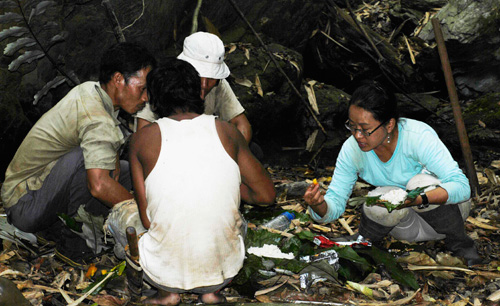 | | Search for lost amphibians of India - Frog hunters taking brunch. Photo: S D Biju |
The following day at the appointed time our two local guides came equipped with dao (local knife) and air guns. We trekked for almost two hours. We reached where our local guides intended to bring us. As we waited our guides prepared our brunch - rice, sliced raw mangoes, chutney made of green chillies and roasted crab. After the sumptuous brunch, Biju got out his last precious cigarette when one of our local guides in a broken Hindi and English asked us if we wanted to have wild honey. We said 'yes' in a chorus. Then the guide said to Biju 'give your cigarette'! I was amused. He disappeared for 10 minutes and came back with honeycombs dripping with honey. I hadn't eaten so much honey nor chewed so much of bee wax in my life! Nightfall came and an army of five people scanned the area but we had no luck. We moved on and came to small puddles and ponds near paddy fields - ideal habitats for Euphlyctis but our croaking friends weren't there. After about 20 person hours of combing we called it a day and retreated to our base camp discussing the strategy for the following day. After a meal in awkward silence we worked on the day's fringe benefits - frogs of other species.
On the second day we decided to go in another direction. An entire day's search yielded other frog species but not the species we specifically came for all the way from Delhi. With our hearts beating at a double pace than normal we trekked up slowly looking for any signs of movement. Hard luck. It was a dry wintry evening and everything was still. Unwillingly, we decided to beat a retreat. We took a short cut and walked in silence but our eyeballs still rolled frantically following the flash lights. Just as we gave up our hopes and doubled our pace to reach our base a wrinkly, fatty-ish frog hopped on to Biju's boots. It looked like the frog we had been looking for! I wondered if it was my imagination. But I was not hallucinating! It was for real that we were there standing in a remote village guarded by our two-day old friends and the frog leapt to us as if it knew we had come a long looking for it! Gingerly, Biju grabbed the hopper. We collected a few more samples before we headed back thrilled but with an unspoken trepidation if it was the one. Back in our base camp we closely examined our find and it did seem to match with Chanda's description of the frog! Well, this is the story of our hunt for the elusive Manipur frog. It was a dicey and expensive choice but I think it was rewarding. We take our rediscovery with a pinch of salt and await a more in depth taxonomic study before we can be sure we have rediscovered the lost Euphlyctis ghoshi. We keep our fingers crossed till then.
|
A ‘frogtrip’ to the Himalayan foot hills |
| Posted by Sonali and Gargi University of Delhi | 07. 01. 2011 | COMMENTS(10) | | | | |
On 23 November, our team of five assembled again. Set forth, on yet another expedition to Chakrata. After a bumpy and much delayed bus ride we were welcomed at Dehra Dun by cool breeze and barking dogs of a sleeping city. We checked into a hotel, barely for a few hours, before boarding an early bus to our final destination: Chakrata, the type localities of two lost amphibians’ – Amolops chakrataensis and A. jaunsari.
As we left the waking city and travelled into the suburbs, we felt the breeze becoming cooler and refreshing. The bus skillfully coursed the hairpin turns. The uninterrupted view of fields and rolling mountains farther away set us reminiscing about the very same journey we had made earlier this year with Dr S D Biju. The only difference was the morning chill and fog that still prevailed, unlike the crispy day break that had greeted us in April.
 | | Search for lost amphibians of India - Gargi, Sonali, Robin and Pratyush. |
This was our second trip to Chakrata. As Masters’ students our colleague Pratyush had decided to survey some places in and around Dehra Dun for his masters dissertation. We, along with Robin and Biju, were more than glad to assist him in his study. It had been an adventurous 5 km trek to our study site- the Tiger falls. We had walked downhill on a narrow path cut along steep slopes, occasionally asking for directions from passing villagers. From a few slips and falls, to getting stung by ‘Bichhu Booti’ (Stinging nettle) and ending up drinking moth flavored water- we all had our first tastes of silly field accidents. But all that was soon forgotten at the site of the breath-taking and towering 312 ft waterfall that had driven us into a clicking frenzy. The untamed water romped over rocks forming swift-flowing channels, rapids and pools. Soon after sunset and departure of the few noisy tourists, we had set about looking for and recording amphibian life of the place. A few curious villagers had lingered on for a while and warned us of bears and bees. With nightfall the whole place had turned alive and our ears gradually got attuned to more frequent frog calls.
What became one of our first field trips as masters’ students was now another exciting journey in search of lost frogs. Amidst nostalgia and déjà vu, an abrupt stop at a check-post announced our arrival at Chakrata, a military cantonment with restricted access. This camp was established by Colonel Hume of the British Forces in 1866. The bus finally stopped at the center of the town. It was a short walk to the hotel which looked cleaner this time than during our previous visit. After lunch we set off to the waterfall- somehow the trek seemed easier. The vast layers of mountains, part of the majestic Himalayas, continued to overwhelm us. The bare slopes had turned greener with cattle grazing here and there. Halfway down, we stopped at the sole tea stall that served us piping hot tea and maggi (a staple of all hill stations of north India).
We resumed the last leg of our trek. As we neared the bottom of the hill, strewn with potato fields, a hissing and gushing noise almost deafened us. We knew we were approaching the famed fall which roared with greater intensity around this time of the year- the name was convincingly well earned. After sunset, we began our hunt for the elusive Amolops. We spotted them- light green with dilated toe discs under our torch lights, perched on rocks close to fast-flowing rapids. Catching them required greater skill. We returned to our room happy and content. Success seemed beautiful with a tinge of green.
 | | Tiger falls, Chakrata. |
On our way back from Chakrata, we stopped at a tiny village named Sahiya. We managed to find a homely accommodation, and by evening set out to search a small stretch of Amlawa River that passes by the village. The stream, flanked by agricultural fields on the sides, made for a disturbed habitat for frogs. After much effort, we were surprised by our find. Brimming with excitement, and looming questions, we left on a homeward journey which seemed longer yet smoother than ever.
The specimens we have require confirmation from studies back in the Systematics lab as to whether they are the two lost Himalayan frogs – Amolops chakrataensis and A. jaunsari. But the joy from even the smallest possibility of a discovery, the thrill of working in wild and the delight of exploring a lesser spoilt piece of nature is in no need of confirmation.
|
| |
 Amrish Amrish |
|
| 14.01.2011 at 12:33 pm |
| Wow..quite an amazing experience. It’s sheer pleasure to move away from the clutter and madness of the cities to the unordered but extremely serene environment in far off villages and montane forests. Its hard work..but very exciting too….Wish I could also be a part of such expeditions!!! |
| |
 Ajith Ajith |
|
| 15.01.2011 at 08:46 pm |
| interesting project!!! All the best |
| |
 sabu sabu |
|
| 21.01.2011 at 01:23 am |
| It is good one! i like |
In search of Rao’s lost species |
| Posted by Dr K V Gururaja IISc Bangalore | 07. 01. 2011 | COMMENTS(33) | | | | |
It was a great gathering of almost all the researchers working on Indian Batrachology at University of Delhi on 2 November 2010. The event was much bigger and aiming to recover as many as 48 species of amphibians, which are now listed as ‘lost amphibians of India’. Sudden and quick plan for a fieldwork has become an integral part of my life. Something very similar happened, when Dr. Biju from University of Delhi called me on 9 November 2010. Within few telephonic conversation, date, time and route was fixed. As a part of search team, Dr. Biju, Dr. Dinesh and me, planned for a search in Kempholey and Kottigehara regions of the Western Ghats. We were all keen about this particular region for the very reason that many of Prof. C.R. Narayan Rao’s (1882-1960) species were reported from here (8 species from Kempholey, 4 species from Kottigehara) and what remains now is his seminal paper titled ‘on some new forms of batrachia from S. India’, while his collections described in the paper are completely lost and enlisted as lost species. For me, it added more delight, as I was for the first time accompanying Dr. Biju in the field.
As it was decided in quick time, we were now in a dilemma about our stay and journey period. Finally we zeroed on dates as 16 and 17 of November, as we felt that one day visit is not sufficient to cover the region. Now three of us are from three different parts of India, Dr. Biju is from Delhi, Dr. Dinesh is from Calicut and I from Bangalore, the problem we faced was ‘where to begin our search journey?’ We kept Bangalore as the starting point and hired a cab for our journey starting very early on 16 November. Meanwhile, Dr. Biju, who has a permission to do research in protected areas of Karnataka also, wrote to Deputy Conservator of Forest, Mangalore for accommodation at Gundia forest guesthouse. I always felt that permission is absolutely needed to do research especially in the protected areas, despite the fact that it takes away lot of time to get one. With a precise co-ordination from three of us, travel and accommodations were arranged within a day.
Dr. Biju joined me in Bangalore on 15 night, while Dr. Dinesh joined us on 16 early morning en-route. We travelled on NH 4 till Nelamangala, after that took left deviation on NH 48. After having breakfast at Kunigal, we headed towards Sakleshpur. Cab driver Srinivas was not aware about the kind of travel we generally do. I briefed him that he really needs to drive slowly in the Kempholey Ghats unlike the way he drove from Bangalore to Sakleshpur in 4 hours whizzed through the traffic. The river is named as Kempholey since it carried red coloured muddy water during the rains (in Kannada, Kemp = red, holey = river).
 | | Search for lost amphibians of India - Dr Gururaja and Dr Dinesh in Kempholey. Photo: S D Biju |
Our first search started at a stream, spaced half way between Sakleshpur and Gundia. We had decided on looking at Micrixalus elegans, which was described as Ixalus elegans in Rao’s paper (1937). All of us equipped with camera and torch, got into the stream and along the edges of the stream. Dr. Biju told us that it is a tiny frog about 20mm with brick red dorsum and look in to forest floor than in streams. Three of us searched the area for about 2 hours till the confluence to Kempholey River. We got the Micrixalus species in the streams, but were not matching the descriptions of Prof. Rao. So our first search did not yield the result we are expecting. Since our energy level was high, we decided to move to the next stream along the Kempholey Ghat.
Again, three of us descended the stream and started searching the ‘Elegant torrent frog’ few hundred meters downstream from the first spot. Yet again, we encountered Micrixalus species which was not we were searching for. I noticed amplected pairs and vocalization of this Micrixalus and captured them in my camera, while Dr. Biju and Dr. Dinesh were busy taking photographs of a Nyctibatrachus species they got from first spot. We spent nearly an hour here. As it was approaching 3 pm and we were all hungry, we decided to have lunch. I was about to reach back, suddenly a tiny little frog near my foot jumped into a litter mass. I caught hold of it and screamed in joy, although I was not certain, whether it was ‘Elegans’ or not. I showed the specimen to Dr. Biju and Dr. Dinesh, they too were happy, but were curious to know how it looked and was it matching to Rao’s description. Dr. Dinesh told me that he missed two individuals in his search in the same spot a few minutes early. After few minutes of discussion, Dr. Biju said that it is one of the Rao’s species, but needs to be careful before declaring as it has to match the measurements and descriptions of Rao and importantly not any of the known members of the genus. With high positive note, we descended Kempholey Ghat and reached Gundia.
We had our lunch at 4:30 pm from a dhaba and went to Gundia forest guest house. For our surprise, the forest guard denied our entry as he had not received any letter from the office. I called Mr. Vijaykumar, DCF, Mangalore and got the confirmation of guest house. In spite of all this, our mind was still revolving around Rao’s specimen.
Late in the evening, we decided to search the frogs, now in the Gundia region. Our search along a stream yielded Indirana, Hylarana, Pseudophilautus wynaadensis and Euphlyctis species. We ended our search by 8:30pm. Soon after the dinner, we photographed the specimens that we had collected during the search. Thus our first day of search came to an end and we slept around 3:30 am.
 | | Search for lost amphibians of India - Dr Dinesh and Biju in Kempholey. Photo: Gururaja |
Day two search operations started at 7:30 am. We vacated our guest house at Gundia and after having a good cup of hot tea, we headed towards Kottigehara (in Kannada, Kottige = cow shed, hara = place). Our breakfast was at Ujire, where I had delivered a talk on ‘Save Frogs’ to school children three days back. We started ascending the Charmadi Ghat by 9 am. Our first search spot (fourth spot of the trip) was in a stream. The steep ascent of the stream along with slippery boulders made our search efforts more exciting. We got larger individuals of Indirana species and a Micrixalus species from this spot.
Our next spot was where previously I and Dr. Dinesh got Ghatophryne ornata. Again this spot had a steep ascent with slippery rock surfaces. As the stream ends with a waterfall, tourists were plenty at the region and had made it worst place for searching frogs. In spite of it we got one individual of Rao’s species, a Nyctibatrachus and a Hylarana. Last spot was a second order stream without much steep. Two more individuals of Rao’s species and two other MIcrixalus species we got from here. Rao’s specimen in this region were brick red as mentioned in his paper. We witnessed foot flagging and vocalization of Micrixalus. We decided to end our search at 1:30 am. We headed towards Chikamagalur from Kottigehara, had our sumptuous lunch with Dr. Dinesh and family at his place. Soon after photography of the individuals and tissue sample collection, I and Dr. Biju started our journey back to Bangalore, while Dr. Dinesh decided to stay back with his parents for a couple of days. During this period, Rao’s species vocalized, clearing my doubts on whether they were adults or not.
Thus our first search for lost amphibians of India came to an end, yet the mind was curious to know about the specimens we got.
|
| 3
Page 1 of 1 • Jump to Page:
[1] |
| |
BLOGS
|
|



